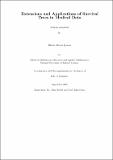| dc.contributor.advisor | Newell, John | |
| dc.contributor.advisor | Hinde, John | |
| dc.contributor.author | Alvarez-Iglesias, Alberto | |
| dc.date.accessioned | 2013-07-31T12:10:51Z | |
| dc.date.available | 2013-07-31T12:10:51Z | |
| dc.date.issued | 2012-09-17 | |
| dc.identifier.uri | http://hdl.handle.net/10379/3583 | |
| dc.description.abstract | Survival trees are a non-parametric modeling strategy that can be included in the area of statistical modeling. These type of models can be used as an alternative to Cox proportional hazards models for the analysis of survival data. Current methods for growing survival trees use estimates of the survival function in the terminal nodes of the tree. In this thesis, a new approach is proposed that incorporates estimates of the mean residual life function as the output of the model. The mean residual life function has been used traditionally in engineering and reliability but can also be used in the analysis of medical data. This function is easier to interpret (values are given in units of time) and summarizes the survival experience of the individuals under investigation in a very simple manner. In addition, this proposal is accompanied by two new methods for growing survival trees and for the estimation of the mean residual life function. The first method is based on a new algorithm called ¿node re-sampling" which uses bootstrapping to incorporate the sampling variability in the process of finding the optimal split in the nodes that are part of the tree. The second method is based on extreme value theory and aims to provide adequate estimates of the mean residual life function when there is incomplete survival information in the right tail of the underlying distribution due to the termination of the study. Throughout the thesis, two datasets are used to illustrate how the proposed methods can be used for the analysis of survival data. One of them consists of patients with cardiovascular disease and the other one consists of women diagnosed with breast cancer, both from the West of Ireland. | en_US |
| dc.rights | Attribution-NonCommercial-NoDerivs 3.0 Ireland | |
| dc.rights.uri | https://creativecommons.org/licenses/by-nc-nd/3.0/ie/ | |
| dc.subject | Survival analysis | en_US |
| dc.subject | Tree based methods | en_US |
| dc.subject | Survival trees | en_US |
| dc.subject | Mean residual life | en_US |
| dc.subject | Statistics | en_US |
| dc.subject | Mathematics | en_US |
| dc.title | Extensions and Applications of Survival Trees in Medical Data | en_US |
| dc.type | Thesis | en_US |
| dc.contributor.funder | IRCSET | en_US |
| dc.local.note | In this thesis, a new approach is proposed that incorporates the mean residual life function as the output of tree based models in medical data. In addition, two new methods are proposed, one for growing survival trees and the other one for the estimation of the mean residual life function. | en_US |
| dc.local.final | Yes | en_US |
| nui.item.downloads | 3095 | |


